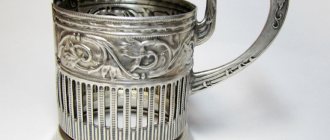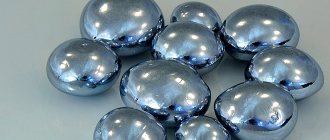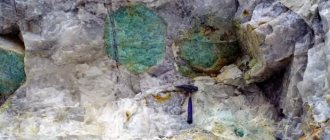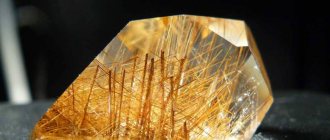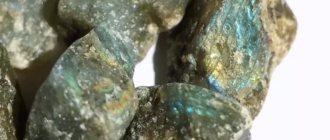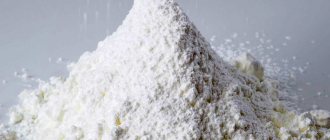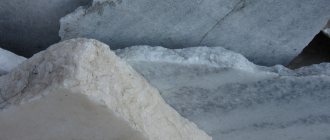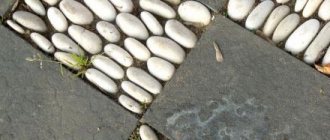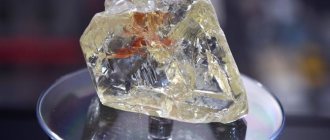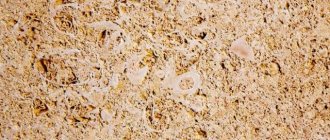Emeralds similar to those mined in the Colombian Muzo deposit can be obtained in laboratory conditions. And not only that: the hydrothermal method makes it possible to synthesize the rarest bixbites, morganites, and amethysts weighing several kilograms. If the synthesis process is controlled, the number of inclusions will be acceptable.
We are proud to note that RusGems is the only company in the world that grows Colombian emerald - the most expensive variety!
I) Verneuil and Czochralski methods
In 1891, Verneuil developed a process for the synthesis of corundum crystals from pure aluminum oxide (Al2O3), and therefore corundum doped with dyes (chromium for rubies, iron and titanium for sapphires, etc.). The first rubies synthesized in this way appeared on the market in 1904, sapphires in 1907, and rubies and star sapphires in 1947.
In this manufacturing process, aluminum powder is melted in the flame of an oxyhydrogen torch, which can create a high temperature flame (up to 2700°C). The powder is introduced through a nozzle that supplies oxygen. Droplets formed in the heart of the flame fall onto the aluminum and crystallize there, forming a cylinder of crystal.
In stones from old production, you can notice areas of color growth and air bubbles. New improvements in this technique and high temperature conditions lead to the appearance of gemstones where these defects are almost invisible.
The so-called "pull" method, developed by Czochralski, involves placing a seed crystal in contact with molten material. The crystallized material is melted in a platinum or iridium crucible. The seed crystal is then lifted upward by rotating in the opposite direction to the rotation of the crucible, drawing out the cooling and crystallizing material with it.
This method can also result in air bubbles trapped in the stone during crystallization.
The Bridgman method involves molten powder in an iridium crucible that is rotated in a housing where the temperature is slowly varied on either side of the melting point of the material being crystallized. The stones grow from the bottom up, forming very pure crystals.
What is hydrothermal emerald - the most interesting
Synthetic is a mineral identical to natural, grown in laboratory conditions. Despite its non-natural origin, the stone is highly valued by jewelers and buyers. Products with it are happily purchased as a more affordable alternative to the expensive original.
In addition, the mineral has serious magical properties and has long been used as a talisman. Hydrothermal emeralds are happily passed down from generation to generation, used as a talisman, and hoped for its protection when going out into the elements and traveling around the world.
The green stone is trusted by everyone who believes in the power of nature, and even human participation in the process of obtaining it does not spoil the effect.
II) Solution-melt method
This method involves crystal components that must be prepared in a solution that does not contain water. To synthesize emeralds, lithium, lead, vanadium molybdates, etc. are used as flux.
In some anhydrous processes, crystals form as a result of spontaneous germination in the flow.
Thus, this process involves, using the example of emerald: the constituents of beryllium, i.e. beryllium oxide, aluminum oxide, silicon oxide (silicon oxide) and chromium salt as a chromophore agent, which are placed in solution at high temperature in a bath of molten salts forming a “stream” (molybdates, anhydrides, etc.).
The ingredients are thus mixed and melted at a temperature of approximately 800°C - 1000°C in a platinum crucible, then cooled slowly and in a controlled manner over the natural crystalline seed material (except in the case of spontaneous germination).
Once the contents of the crucible are dissolved, crystals are produced, the sizes of which depend on the amount of compound material initially introduced, the time and the temperature gradient used for melting and cooling.
This process (sometimes incorrectly called diffusion treatment) is actually associated with synthetic stones. Indeed, some colorless or low-grade corundums can be used as seeds in the synthesis process. This creates a large stone with a thin layer of colored synthetic corundum around it (sapphire ruby, etc.).
Various manufacturing procedures are often named after the scientist who developed them or the company that uses and sells the stones resulting from the process.
Recommendations
- The earliest appearance of the word "hydrothermal" is: Sir Charles Lyell, Textbook of Elementary Geology
..., 5th ed. (Boston, MA: Little, Brown and Company, 1855), p. 603: “The theory of metamorphism [requires us to confirm] that the action existing in the interior of the earth at an unknown depth, whether thermal, hydrothermal,...” - O'Donoghue, M. (1983). A Guide to Artificial Gemstones
. UK: Van Nostrand Reinhold Company. pp. 40–44. ISBN 0-442-27253-7. - Schubert, Ulrich. and Husing, Nicola. (2012) Synthesis of Inorganic Materials Weinheim: Wiley-VCH, p. 161
- For a more detailed history of hydrothermal synthesis, see: K. Birappa and Masahiro Yoshimura, Handbook of Hydrothermal Technology
(Norwich, NY: Noyes Publications, 2001), Chapter 2: History of Hydrothermal Technology. - Schafhäutl (1845) "Die neuesten geologischen Hypothesen und ihr Verhältniß zur Naturwissenschaft überhaupt" (The latest geological hypotheses and their relation to science in general), Gelehrte Anzeigen
(published by: die königliche Bayerische Akademie der Wissenschaften (Royal Bavarian Academy of Sciences)),
20
: 557, 561-567, 569-576, 577-596.
On page 578, he states: “ 5) Bildeten sich aus Wasser, in welchen ich im Papinianischen Topfe frisch gefällte Kieselsäure aufgelöst hatte, beym Verdampfen schon nach 8 Tagen Krystalle, die zwar mikroscopisch, aber sehr wohl erkenntlich aus benmenseitréitr.
“(5) From the water in which I dissolved the freshly precipitated silicic acid in the Papen pot [i.e. in a pressure cooker], after just 8 days of evaporation, crystals formed which, although microscopic, consisted of very easily recognizable hexagonal prisms with their usual pyramids.) - R. Bunsen (1848) "Bemerkungen zu einigen Einwürfen gegen mehrere Ansichten über die chemisch-geologischen Erscheinungen in Island" (Comments on some objections to several views on chemical-geological phenomena in Iceland), Annalen der Chemie und Pharmacie
,
65
: 70- 85. On page 83 Bunsen mentions the crystallization of carbonate salts of barium, strontium, etc. ("Die kohlensauren Salze der Baryterde, Strontianerde, etc."). - See:
- de Senarmont (1849) “Experiments in the creation of artificial materials associated with the use of mineral substances that were previously created as a result of the use of thermal springs in accordance with combined actions carried out in accordance with the principles of work and pressure” (Experiments on the artificial formation from a solution of certain minerals substances that could be formed in hot springs under the combined action of heat and pressure) Comptes rendus
...,
28
: 693-696.
E. de Senarmont (1851) “Note sur la education artificielle, par voie humide, du corindon et du diaspore” (Note on the artificial formation of corundum and diaspore from solution), Comptes rendus
…,
32
: 762-763. - de Senarmont (1849) “Experiments in the creation of artificial materials associated with the use of mineral substances that were previously created as a result of the use of thermal springs in accordance with combined actions carried out in accordance with the principles of work and pressure” (Experiments on the artificial formation from a solution of certain minerals substances that could be formed in hot springs under the combined action of heat and pressure) Comptes rendus
- "Hydrothermal crystal growth—quartz." Roditi International. Retrieved 2006-11-17.
- Giorgio Spezia (1905) "La pressione è chimicamente inattiva nella solubilità e ricostituzione del Quarzo" (Pressure is chemically inactive in the solubility and reduction of quartz), Atti della Reale Accademia delle scienze di Torino
(Proceedings of the Royal Academy of Sciences of Turin),
40
: 254- 262. - Makwan, Denis Makwan (2012). Sand and Silicon: The Science That Changed the World
. Oxford Univ. Click. paragraph 11. ISBN 978-0199640270. - Laudis, R.A. (1958). R. H. Doremus; B. W. Roberts; D. Turnbull (ed.). Growth and improvement of crystals.
Proceedings of the International Conference on Crystal Growing, held in Cooperstown, New York, August 27–29, 1958 . Wiley, New York. pp. 458–463.
III) Hydrothermal synthesis method
At high temperatures and pressures, water (more precisely, elemental or acidic solutions) can behave as a solvent for mineral species. This phenomenon, close to nature, is used to obtain crystals of very high purity by placing them in an autoclave.
An aqueous solution in an autoclave-type stainless steel cylinder (sometimes coated with precious metals such as platinum, gold or iridium) containing silicon (at the top or bottom of the cylinder depending on the option) and nutrients at the bottom of the cylinder is heated in the event of synthesis emeralds in the range of 350-600°C and under pressure from 250 to 1500 kg/cm2.
Crystallization occurs around the seed crystal due to a temperature change (about 10°C) between the bottom and top of the cylinder.
Convection movements of the fluid transport the heaviest components to the top of the cylinder. The fact that the top of the cylinder is less hot results in a cooling effect that directs the convection movement of the solution towards the center and bottom of the cylinder and thus towards the seed crystal. This is how it grows.
The conditions in this process can be compared to those in natural deposits, although they differ significantly in the absence of carbon dioxide, which plays a very important role in natural deposits.
The crystals produced in this way are especially pure and sometimes very large in size.
Story
Synthetic quartz crystals produced in an autoclave shown at Western Electrics Pilot hydrothermal quartz plant in 1959.
First report of hydrothermal crystal growth.[4] was the German geologist Carl Emil von Schafheutl (1803–1890) in 1845: he grew microscopic quartz crystals in a pressure cooker.[5] In 1848, Robert Bunsen reported growing barium and strontium carbonate crystals at 200 °C and 15 atmospheres of pressure using sealed glass tubes and aqueous ammonium chloride ( "Salmiak"
) as a solvent.[6] In 1849 and 1851, French crystallographer Henri Huroux de Sénarmont (1808–1862) produced crystals of various minerals by hydrothermal synthesis.[7][8] Later (1905), Giorgio Spezia (1842–1911) published reports on the growth of macroscopic crystals.[9] He used sodium silicate solutions, natural crystals as seeds and supplies, and a silver-plated vessel. By heating the supply end of his vessel to 320–350 °C and the other end to 165–180 °C, he obtained about 15 mm of new growth over a 200-day period. Contrary to modern practice, the hottest part of the ship was at the top. A shortage in the electronics industry of natural quartz crystals from Brazil during World War II led to the post-war development of the hydrothermal process on an industrial scale to cultivate A.S. quartz crystals. Walker and Ernie Buehler in 1950 at Bell Laboratories.[10] Other notable contributions were made by Nacken (1946), Hale (1948), Brown (1951), and Kochman (1955).[11]
IV) High pressure and high temperature (HPHT)
Synthetic diamonds vary, for example, in the 50,000 to 100,000 atmospheres of pressure and 1,000 to 2,800°C temperatures that may be required to produce them.
In 1955, General Electric subjected carbonaceous substances to pressures of more than 100,000 atmospheres in a pyrophyllite chamber and temperatures of more than 2760°C, and obtained fine crystals under these critical conditions. The presence of nickel and other catalyst metals promoted the transition from graphite to diamond, but the samples were magnetic.
In 1970, the same company announced the creation of a crystal larger than one carat. The cost of the stone at that time was significantly higher than the price of the same natural diamond.
Chatham supplies diamonds of all colors produced by casting nickel and iron at 1000°C at 50,000 atm. The diamonds formed in this way are quite large and of jewelry quality with inclusions. With the same quality, their prices today are three times lower than those of their natural counterparts.
Florida-based Gemesis Corp produces a wide variety of synthetic diamonds ranging in color from yellow to orange.
This company is expected to start producing non-yellow diamonds very soon. The Gemesis method produces diamonds weighing more than 3.5 carats with distinct crystalline forms. These high quality stones also have inclusions.
V) Chemical vapor deposition (CVD)
“CVD” is what we call “chemical vapor deposition.”
Chemical vapor deposition (CVD) is used today (2004) almost exclusively for diamond synthesis.
This method, developed by them or Apollo Diamond Inc, uses the activation of a mixture of methane (CH4) and hydrogen (H2) gases, with or without additions such as nitrogen (N2) or diborane (B2H6).
Activation of the vapor phase (transformation into plasma) occurs due to high temperatures generated by a microwave, filament or plasma torch.
The deposition of radicals (eg CH3) generated in this vapor phase occurs on a preformed natural or synthetic diamond substrate as a growth “seed” in the temperature range of 800 to 1000°C.
The diamonds thus formed show a development that is very different from natural or synthetic diamonds produced by HPHT.
These CVD synthetic diamonds can be any shade of brown as long as nitrogen is present in the vapor phase. This is the most common case encountered today because complete absence of nitrogen is difficult to achieve in this type of process. These brown diamonds may be more or less discolored.
The resulting single crystals can be completely colorless and extremely pure if only hydrogen and methane are used in the gas mixture.
But to obtain such results, the technique is still difficult to apply, and the growth time is much longer.
CVD diamonds can also be doped with boron (B) to create a type of diamond with shades ranging from pale grey-blue to fancy deep blue.
Diamonds obtained as a result of this CVD synthesis method have spectral and luminescent properties, as well as some growth defects specific to them, but these properties are often observed only when using expensive equipment.
However, this type of synthetic diamond, like HPHT stones, can be distinguished from natural diamonds using certain compact rapid testing devices such as DiamondSure.
There is no doubt that this technique, which is now increasingly being developed, has a bright future for the large-scale production of synthetic diamonds that can be used in jewelry.
How to wear and care
Modern jewelry and costume jewelry with quartz stones are suitable for almost all styles of clothing. Stones of warm shades are recommended to be worn by representatives of warm color types: these are chrysolites, carnelians, citrines, ametrines.
Amethysts and rose quartz are more suitable for people with cool skin tones. Stones such as cacholongs or morions are universal.
Sunlight and cosmetics are harmful to the stone; it loses its brightness, becoming faded. How to make jewelry with quartz delight you with its beauty for many years? To do this, you need to properly care for them:
- For storage, use special boxes protected from direct sunlight;
- Once every six months, wash the products in a soapy solution with the addition of ammonia, then rinse with plenty of running water.
VI) Sedimentation
Sedimentation is most often used to synthesize opal and involves (in the case of noble opal synthesis) a chemical reaction with silicic acid, resulting in the formation of silicon elements, which then remain permanently in the sedimentary layer.
Amorphous hydrated elements from silicon are organized into ordered layers, which ultimately give the most valuable play of color. The reaction solvents (alcohols) must be allowed to evaporate very slowly.
In this process, during drying, the silicon grains, under the influence of stress, are organized into groups (clusters), which give an effect known as “lizard skin”, observed under magnification. Opals were first prepared in this way by French chemist Pierre Gilson in the 1970s.
There are other “recipes” for the synthesis of noble opal.
Some syntheses, involving compounds such as zirconia (ZrO2) and most likely a thermal process, often have a columnar appearance, and can be considered almost like a type of ceramic.
VII) Gilson's method
The famous French chemist and ceramicist Pierre Gilson at one time developed, in addition to opals, materials that imitated corals and lapis lazuli so well that they were sometimes called “synthetic corals” or “synthetic lapis lazuli.” However, certain chemical and/or structural differences compared to natural stones make them classified as imitation materials.
Turquoise was also reproduced by Gilson. In this case, the material can be considered as a true synthesis, since the physicochemical characteristics of the natural material are respected.
Ceramic processes involve physical and/or chemical assemblies carried out under heat and/or pressure.
Synthetic opal can also seem to be considered a form of ceramic.
External links [edit]
- Manufacturer of equipment for growing hydrothermal crystals
- Hydrothermal growth of quartz crystals
| vteChemical synthesis | |
| Types |
|
| |
VIII) Other synthesis routes
Alone or with the help of reagents, solid particles can be changed by temperature from a solid to a gaseous state, and these vapors can be transported and manipulated to cause them to be reduced and crystallized into single crystals.
Such syntheses have been carried out successfully (for example, for ruby), but usually produce small crystals in the form of needles and flakes. This type of synthesis is not yet used in the industrial production of stones.
It should be noted here that similar processes, such as CVD synthesis (see above), have not been used for the commercial production of single crystal gemstones until recently.
The CVD method is currently used to produce diamonds in commercial quantities and quality.
Interesting Facts
Quartz is a stone that has always been endowed with magical properties that can change a person’s destiny. Therefore, in museums you can see various artifacts made from it. Moreover, in most cases, single crystals were used.
The secret of processing quartz crystals was known to the Assyrians.
During excavations of Mayan cities, a skull made of crystal using laser technology was found. The age of the artifact exceeds two thousand years.
The quality of porcelain is determined by the purity of quartz sand, which, together with kaolin, is the basis for the production of porcelain charge. The first information about this is found in ancient Chinese historians.
To give amethysts a deep purple color, jewelers heat them to 600 – 700°C. It should be noted that the passport for the stone should contain information about this.
The largest unprocessed quartz crystal is on display in one of the St. Petersburg museums.
The Thai island of Koh Phangan, made of rose quartz, attracts yoga practitioners. This mineral is responsible for the heart chakra, so the most incredible transformations are possible on the island when performing yogic practices.
Chemical reaction
Chinese scientists have managed to synthesize large microparticles of high-quality diamonds from carbon dioxide (using sodium metal at a temperature of 440°C and a pressure of 800 atmospheres in an autoclave).
The gemstones synthesized in this way were tested by Raman spectroscopic and X-ray diffraction instruments. Scanning electron microscopy showed that these diamond particles range in size from 10 to 250 microns. Under an optical microscope, these diamonds appear colorless and transparent.
The resulting cubic diamonds are of very high quality, and at this relatively low temperature, this method can be used to make large gemstones with CO2 as a directly available carbon source.
More detailed information can be found at https://www.geminterest.com/synthese.php
What is the price
Quartz occurs in nature in different states and types. These can be individual crystals or rocks. Therefore, the question “how much does it cost?” depends on the following factors:
- purpose of the mineral;
- the difficulty of its extraction;
- size of the deposit.
The most expensive stone is quartz, intended for decorating jewelry. Such crystals are usually sold at auctions, their price is determined:
- cleanliness;
- transparency;
- absence of defects;
- coloring;
- size.
The most valuable among minerals is the amethyst gemstone; the price for large crystals of rich purple tones reaches tens of thousands of dollars. Average quality crystals with mediocre color usually cost $10 – $80 per carat.
Rutile precious quartz is also highly valued in the jewelry market. It attracts attention with needle-like inclusions in transparent quartz crystals; their cost can also reach tens of thousands of dollars for a unique specimen. In addition, the cost is due to the fact that quartz is difficult to extract from natural stone without damaging the needle-like structures.
